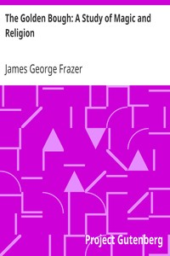

The Golden Bough (1890)
by Sir James George Frazer


Nowhere is the theory of sympathetic magic more systematically carried into practice for the maintenance of the food supply than in the barren regions of Central Australia. Here the tribes are divided into a number of totem clans, each of which is charged with the duty of multiplying their totem for the good of the community by means of magical ceremonies. Most of the totems are edible animals and plants, and the general result supposed to be accomplished by these ceremonies is that of supplying the tribe with food and other necessaries. Often the rites consist of an imitation of the effect which the people desire to produce; in other words, their magic is homoeopathic or imitative. Thus among the Warramunga the headman of the white cockatoo totem seeks to multiply white cockatoos by holding an effigy of the bird and mimicking its harsh cry. Among the Arunta the men of the witchetty grub totem perform ceremonies for multiplying the grub which the other members of the tribe use as food. One of the ceremonies is a pantomime representing the fully-developed insect in the act of emerging from the chrysalis. A long narrow structure of branches is set up to imitate the chrysalis case of the grub. In this structure a number of men, who have the grub for their totem, sit and sing of the creature in its various stages. Then they shuffle out of it in a squatting posture, and as they do so they sing of the insect emerging from the chrysalis. This is supposed to multiply the numbers of the grubs. Again, in order to multiply emus, which are an important article of food, the men of the emu totem paint on the ground the sacred design of their totem, especially the parts of the emu which they like best to eat, namely, the fat and the eggs. Round this painting the men sit and sing. Afterwards performers, wearing head-dresses to represent the long neck and small head of the emu, mimic the appearance of the bird as it stands aimlessly peering about in all directions.🏁
Global Leaderboard
| # | Player | Time | Duration | Accuracy | WPM | pp | |
|---|---|---|---|---|---|---|---|
| 1 | |||||||
| 2 | |||||||
| 3 | |||||||
| 4 | |||||||
| 5 | |||||||
| 6 | |||||||
| 7 | |||||||
| 8 | |||||||
| 9 | |||||||
| 10 |


Nowhere is the theory of sympathetic magic more systematically carried into practice for the maintenance of the food supply than in the barren regions of Central Australia. Here the tribes are divided into a number of totem clans, each of which is charged with the duty of multiplying their totem for the good of the community by means of magical ceremonies. Most of the totems are edible animals and plants, and the general result supposed to be accomplished by these ceremonies is that of supplying the tribe with food and other necessaries. Often the rites consist of an imitation of the effect which the people desire to produce; in other words, their magic is homoeopathic or imitative. Thus among the Warramunga the headman of the white cockatoo totem seeks to multiply white cockatoos by holding an effigy of the bird and mimicking its harsh cry. Among the Arunta the men of the witchetty grub totem perform ceremonies for multiplying the grub which the other members of the tribe use as food. One of the ceremonies is a pantomime representing the fully-developed insect in the act of emerging from the chrysalis. A long narrow structure of branches is set up to imitate the chrysalis case of the grub. In this structure a number of men, who have the grub for their totem, sit and sing of the creature in its various stages. Then they shuffle out of it in a squatting posture, and as they do so they sing of the insect emerging from the chrysalis. This is supposed to multiply the numbers of the grubs. Again, in order to multiply emus, which are an important article of food, the men of the emu totem paint on the ground the sacred design of their totem, especially the parts of the emu which they like best to eat, namely, the fat and the eggs. Round this painting the men sit and sing. Afterwards performers, wearing head-dresses to represent the long neck and small head of the emu, mimic the appearance of the bird as it stands aimlessly peering about in all directions.🏁